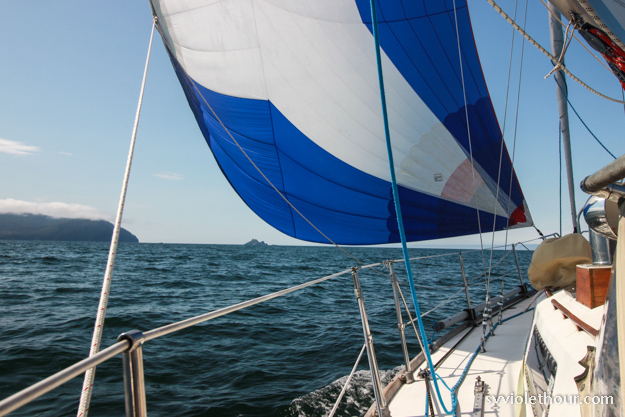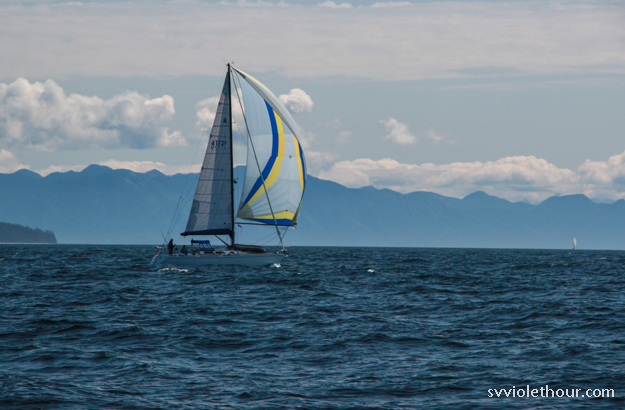To a sailor there’s nothing more exciting than feeling the boat power up in a strong breeze. The boat digs in to the swell and takes off, using only the power of the wind. Everything is in harmony – the rig, the sails, the rudder. At times like these one of my favorite things is to go below. Listening to the sound of water rushing past the hull always brings forth a sense of wonderment.
In a book I’m reading, “Alone Together” by Christian Williams, he puts it aptly: “To sail a boat across water using only the wind is like a miracle, every time. The wind is free and gives its gift not just to you but to the waves and the sky, the clouds and the birds, who all move with it, day and night.”
Our rounding of the Brooks Peninsula was just about perfect, and we couldn’t have asked for a better day. It was a combination of patience and luck – patience for waiting out persistent southerlies and rain, and luck that all the variables aligned. A forecast of NW 10-20, low swell state, and a warm sunny day.

The distinctive Solander Island is just a bit offshore of Brooks Peninsula, and has a wind reporting station.
The Brooks Peninsula, and Cape Cook at its northwesternmost point, jut out about 8 nautical miles into the Pacific Ocean, the largest promontory of Vancouver Island. The Brooks Peninsula is feared and respected by mariners because it creates a powerful wind acceleration zone and also potentially confused seas from headland interactions and up to 1.5 knots of current flowing by.

Our guidebooks said that Cape Cook is the most difficult obstacle of a circumnavigation of Vancouver Island. With the ideal conditions though, it was one of our easiest sails. I can certainly imagine it being tough though – it’s common to hear a forecast for W Van Isle N of NW 15-25 except NW 25-35 at the Brooks Peninsula.

Flying our spinnaker approaching Brooks Peninsula and Solander Island
Sailor Beta – Trip Notes
The forecast was NW 10-20 and Solander Island was getting NW 12-14 at the 6am, 7am, 8am readings. Cape Scott was reporting calm, low SW swell. We departed Klaskino anchorage at 8:15am and motored about 30 minutes to get out into Brooks Bay and into some light wind. With NW 7-12, we put up the spinnaker and tried to catch up to S/V Jag, who we had met in Klaskino. Another sailboat, faster than us, gradually approached from the north, eventually overtaking us with their symmetrical spinnaker.

The swell was barely noticeable – maybe 2 foot, long interval, with 1 foot wind waves. E Dellwood buoy in Q Sound reported 0.8m at 7am (no closer buoy is available because S Brooks is down). About 2 nm north of Cape Cook, we did get some more confused waves, likely from wind wave refraction off the Cape and current against wind. South of Cape Cook we had a strong opposing current of at least 1 knot.
Winds picked up to 20 knots approaching Clerke Point (the southwestern point of Brooks Peninsula), along with more boisterous wind waves, and we doused the spinnaker – switching to our 135% genoa (which actually propelled us faster, up to 7 knots, but under better control).

We scraped by Clerke Point, narrowly avoiding the reefs, because the opposing current was pushing us towards the point and making our gybe angle worse than expected (we should’ve put a little more money in the bank). We could always gybe again if needed. After Clerke Point the wind backed to westerly and followed us in until it died about 2 nm from Columbia Cove.
Coming Up
We’ll be spending 5-7 days in the Kyoquot Sound area, and visiting Walters Cove for reprovisioning on Friday.

I really enjoy following your journey as well as your thoughts about rounding Van Island. One question though – from the above chart it seems you stayed relative close to shore. I would think if you sailed further out you could avoid some of the confused seas, at the cost of not being able to visit all of the inlets but only a few of them. Did you choose staying so close to the shore because you wanted to visit as much of the island as you can?
Yes, generally we’re doing day passages so we can visit as many of the great anchorages as possible. Some people sail longer or further offshore, but then we would’ve missed beautiful Columbia Cove for example. Seas near shore were pretty good this day, and if we go further out that extends the distance sailed which increases chances of losing the wind at some point (often lightens in the evening).
Thanks for stopping by and commenting!